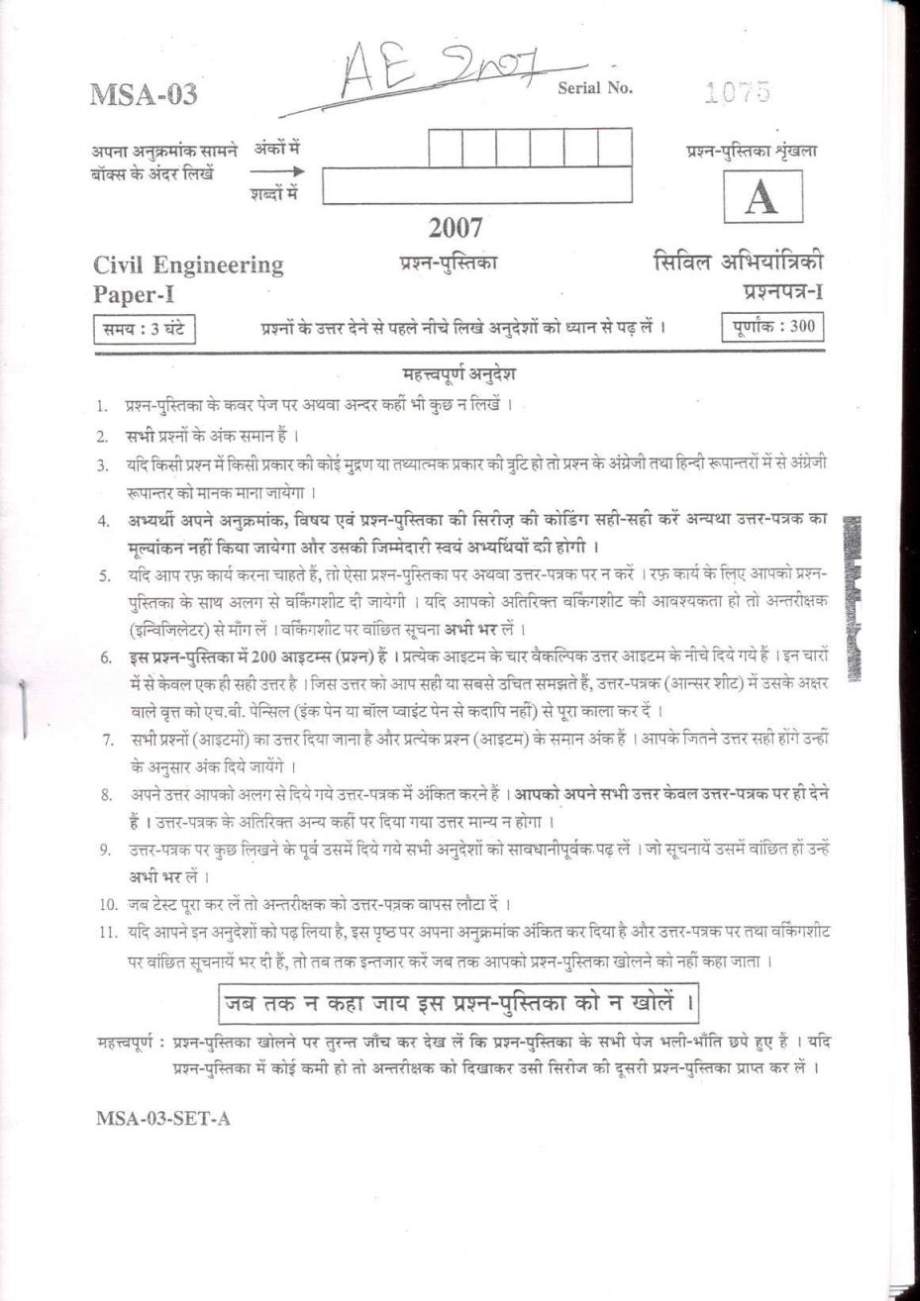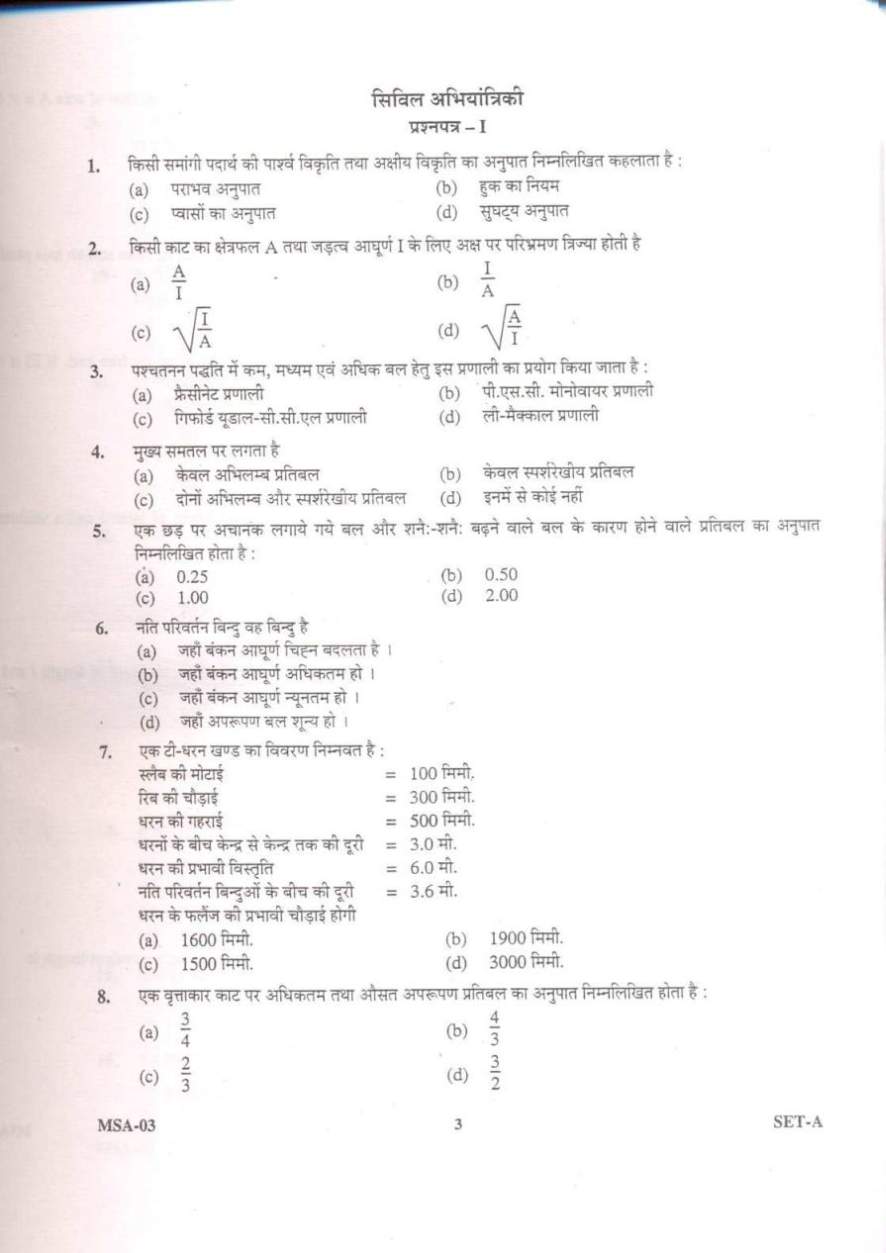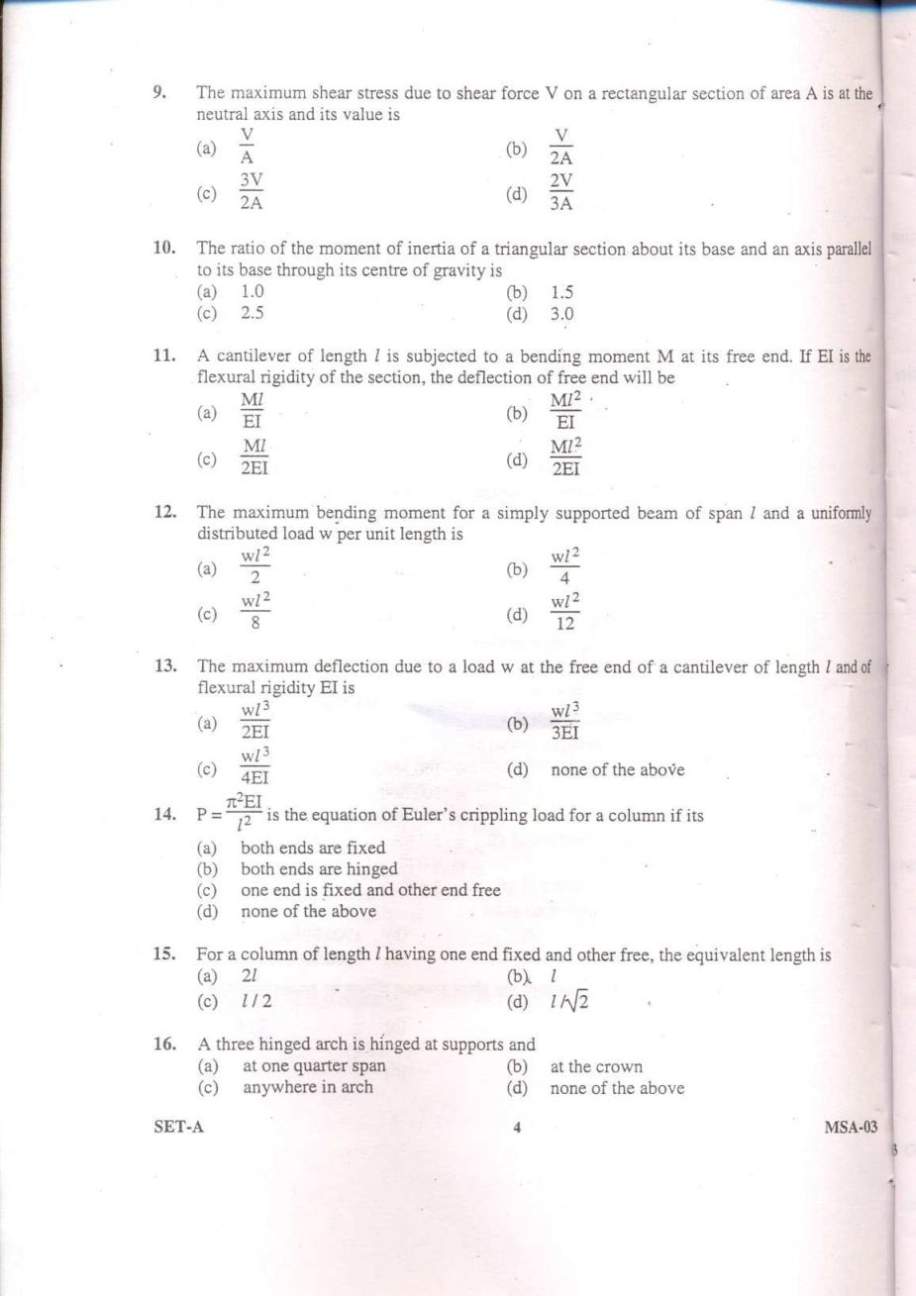| Re: OFB Exam Question Paper
Here I am providing the list of few questions of Indian Ordnance Factory Chargeman General Engineering Exam Question Paper which you are looking for .
Q.1. How much energy will be required to heat one gm of water from 30 deg C to 40 deg C:
(A) 10 Kilo Calories (B) 10 Calories (C) 10 Watts (D) 10 Btu
Q.2. The result obtained by dividing 0.18 by 0.09 will be:
(A) 0.2 (B) 0.02 (C) 2 (D) 20
Q.3. If A : B = 1 : 2 and B : C = 4 : 5 then the ratio between A : B : C will be:
(A) 1 : 2 : 4 (B) 2 : 4 : 5 (C) 3 : 4 : 5 (D) 4 : 5 : 6
Q.4. A metallic alloy consists of 3 metals X, Y & Z and have proportionate weight ratio of 3 :
4 : 5. What will be the weight of metal Y if the total weight of alloy is 300 Kg.
(A) 75 Kg (B) 125 Kg (C) 75 Kg (D) None of these
Q.5. One solder is made of 45% of tin & 55% of lead, what will be the quantity of tin & lead
in 28 kg of solder:
(A) 12 & 16 Kg (B) 15.4 & 12.6 Kg (C) 12.6 & 15.4 Kg (D) 16 & 12 Kg
Q.6. After simplification of ( 3 / 4 ) + ( 2 / 5 ) – ( 7 / 20 ), we will get:
(A) 19 / 40 (B) 9 / 20 (C) 4 / 5 (D) 17 / 20
Q.7. Convert 0.485 into percentage:
(A) 0.485 % (B) 4.85 % (C) 48.5 % (D) 485 %
Q.8. From the following two equations, the value of X & Y will be respectively:
X + 3 Y = 8
2 X + 5 Y = 12
(A) ? 4, 4 (B) 3.5, 1 (C) 1, 2 (D) 2, 2
Q.9. The co-ordinates of four points are given below. Which point is lying in 4th quadrant:
(A) ( 5, 6 ) (B) (? 5, 6) (C) (5, ? 6) (D) (? 5, ? 6)
Q.10.The slip gauge used to prevent the exposed faces of a slip pack from damage is
called?
(A)Tolerance (B) Center offset (C) Wrong alignment (D) None of these
Q.11. Least Common Multiple (LCM) of 30, 36, 48 & 60 will be:
(A) 480 (B) 640 (C) 720 (D) 960
Q.12. The square of 4.5 will be:
(A) 9 (B) 22.25 (C) 21.25 (D) 20.25
Q.13. Area of 4 walls is given by:
(A) l . b . h (B) ( l + b ) h (C) 2 h ( l + b ) (D) h ( l + b ) / 2
Q.14. Which of the following statement is not true ?
(A) The quantity of matter which a substance contains is its mass
(B) The mass varies from place to place
(C) The unit of mass is gm
(D) The mass is measured by a common “Tarazu”
Q.15. Water in an overhead tank is an example of:
(A) Kinetic energy (B) Potential energy (C) Both (A) & (B) (D) None of these
Q.16. One mile is equal to _____ Kms:
(A) 1.609 Km (B) 0.88 Km (C) 1.33 Km (D) 3 Kms
Q.17. 4th root of “ 16 “ will be:
(A) 4 (B) 8 (C) 256 (D) 2
Q.18. The helical angle determines?
(A) Rake angle (B) Cutting angle (C) Lip angle (D) Chew angle
Q.19. Area of the parallelogram is given by:
(A) length x breadth (B) 2 (length + breadth) (C) base x height (D) None of these
Q.20. Ohm’s law is given by:
(A) V = I / R (B) V = R / I (C) I = R / V (D) V = I . R
Q.21. Thermal efficiency of the furnaces can be improved by:
(A) Waste heat recovery from flue gas
(B) Minimising heat losses from the furnace walls
(C) Maintaining proper draught
(D) All of the above
Q.22. Brass is an alloy of:
(A) Nickel & Iron (B) Copper, Tin & Zinc (C) Copper & Zinc (D) Copper & Tin
Q.23. The diameter of the ball used in Brinel Hardness (BHN
(A) 5 mm (B) 10 mm (C) 20 mm (D) 15 mm
Q.24. Rockwell hardness test is useful only for:
(A) Hard metals (B) Soft metal (C) Both (A) & (B) (D) None of these
Q.25. Extrusion process is used for producing:
(A) Rods (B) Tubes (C) Channels (D) All of these
Q.26. Duralumin is an alloy of:
(A) Aluminium & Ni & Mn (B) Aluminium & Copper & Manganese (C) Aluminium & Zinc (D)
Aluminium & Si
Q.27. In vicker hardness testing indentor is:
(A) 5 mm ball (B) 10 mm ball (C) Square based pyramid (D) Diamond ball
Q.28. To measure 1400oC temperature, the following thermocouple is used:
(A) Copper - Constant (B) Aluminium - Chromel (C) Platinum - Platinumrhodium (D) None
of these
Q.29. The teeth of spur gear is hardened by:
(A) Cold working (B) Quenching (C) Induction hardening (D) Dispersion hardening
Q.30. In ultrasonic testing, the frequency required to investigate coarse grained material is:
(A) Low frequency (B) High frequency (C) Medium frequency (D) Either low or higher
frequency
Q.31. TIG welding is useful in welding of:
(A) Stainless steel (B) Aluminium (C) Cast Iron (D) Titanium
Q.32. At what temperature deg C & deg F are equal:
(A) 0 deg (B) ? 40 deg (C) 32 deg (D) None of these
Q.33. The unit of calorific value is:
(A) K Cal / kg (B) K Cal (C) Calories (D) None of these
Q.34. Steel glasses are made by:
(A) Forging (B) Deep drawing (C) Machining (D) None of these
Q.35. ‘Patenting’ heat treatment is used in:
(A) Rolling (B) Wire drawing (C) Extrusion (D) Forging
Q.36. Main function of riser is:
(A) For escape of hot gases
(B) To feed the metal to the casting
(C) To help flow of metal towards the mould cavity
(D) None of these
Q.37. Basic refractory is:
(A) Fire clay (B) Silica (C) Chrome magnasite (D) None of these
Q.38. Magnetic particle inspection is suitable for checking surface defect of:
(A) Non-ferromagnetic items (B) Ferromagnetic items (C) Both (A) & (B) (D) None of these
Q.39. Melting point of pure copper is:
(A) 1981 deg F (B) 1600 deg F (C) 500 deg F (D) None of these
Q.40. Anodising is the process of creating:
(A) Chromium oxide layer on the surface
(B) Aluminium oxide layer on the surface
(C) Zinc oxide layer on the surface
(D) None of these
Q.41. Izode impact is used for determining:
(A) Toughness of material (B) Ductility (C) Fatigue strength (D) None of these
Q.42. Boron in steel as alloying element increases:
(A) Corrosion resistance (B) Magnetic quality (C) Depth of hardening (D) Machinability
Q.43. Nickel as alloying element in steel increases:
(A) Strength (B) Toughness (C) Resistance to heat (D) All of these
Q.44. Cast iron is an alloy of:
(A) Iron & Carbon (B) Iron & Nickel (C) Iron, Carbon & Silicon (D) Iron & Silicon
Q.45. Small precision castings are generally made by:
(A) Centrifugal process (B) Shell moulding (C) Lost wax (D) Die casting
Q.46. The luster of a metal is due to:
(A) Its high density (B) Its high polishing (C) Its chemical inertness (D) Presence of free
electrons
Q.47. Lowest hardness is obtained in steel by:
(A) Hardening (B) Annealing (C) Normalising (D) None of these
Q.48. Carbon is present in the form of graphite flakes in:
(A) Grey Cast Iron (B) White Cast Iron (C) Malleable Cast Iron (D) None of these
Q.49. Etching solution used for steel & cast iron is:
(A) Picral (B) 50% NH4OH solution (C) Nital (D) 1% HF in water
Q.50. Solder is an alloy of tin and:
(A) Lead (B) Antimony (C) Copper (D) Nickel
Q.51. Aluminium metal is refined by the following process:
(A) Baeyer’s process (B) Hoop’s process (C) Hall’s process (D) None of these
Q.52. Cupola is used for producing:
(A) Pig Iron (B) Cast Iron (C) Wrought Iron (D) All of these
Q.53. Melting point of Aluminium is:
(A) 800 deg C (B) 720 deg C (C) 660 deg C (D) None of these
Q.54. Temperature generated in Arc welding is in the order of:
(A) 1500 deg C (B) 2500 deg C (C) 5500 deg C (D) 8500 deg C
Q.55. Aluminimum & its alloy find application in aerospace industry because of its:
(A) Cheap availability (B) Brightness (C) High strength to weight ratio (D) Softness
Q.56. Fluorescent dye penetrant test is used for detecting:
(A) Surface cracks (B) Internal defects (C) Structural characteristics (D) Flaws in magnetic
material only
Q.57. Load applied in Rockwell hardness test scale 'C' is:
(A) 50 Kg (B) 100 Kg (C) 150 Kg (D) 3000 Kg
Q.58. Which is an acidic refractory:
(A) Magnesite (B) Dolomite (C) Fire clay (D) Chrome Magnesite
Q.59. Anodising is given to items of:
(A) Aluminium (B) Copper (C) Steel (D) All of these
Q.60. For Induction hardening of the surface of the component, the frequency used is:
(A) Low frequency (B) High frequency (C) Both (A) & (B) (D) Very high frequency
Q.61. Impact strength of a material is a measure of its:
(A) Hardness (B) Toughness (C) Elasticity (D) None of these
Q.62. Orsat's apparatus is used for checking the content of:
(A) Iron (B) Sodium (C) Carbon (D) None of these
Q.63. The size of a sine bar is specified by the?
(A) Length (B) Weight (C) Maximum angle of setting (D) Measurement of width
Q.64. Hardening of steel is always followed by:
(A) Annealing (B) Normalising (C) Carburising (D) Tempering
Q.65.The type of jig used for location from a bore is the?
(A) Post jig (B) Drill jig (C) Solid jig (D) Box jig
Q.66. In SG Iron, graphite will be in the form of:
(A) Flakes (B) Spheroids (C) Hexagonal shape (D) Square shape
Q.67. Which one of this is not case hardening:
(A) Carburising (B) Nitriding (C) Homogenising (D) Carbonitriding
Q.68. Melting point of pure Iron is:
(A) 900 deg C (B) 660 deg C (C) 1550 deg C (D) None of these
Q.69. Common known high speed steel is:
(A) 18 : 4 : 1 (B) 14 : 8 : 2 (C) 18 : 4 : 2 (D) 16 : 4 : 2
Q.70. Softest phase in Iron – Carbon equilibrium diagram:
(A) Cementite (B) Ferrite (C) Pearlite (D) Austenite
Q.71. Graphite forming element in cast Iron:
(A) Si (B) Al (C) Ni (D) All of these
Q.72. Pearlite is a mixture of:
(A) Ferrite & Cementite (B) Martensite & Ferrite (C) Ferrite & Bainite (D) None of these
Q.73. Manganese in alloy steel improves its:
(A) Corrossion resistance (B) Cutting ability (C) Abrassive resistance & toughness (D) Creep
resistance
Q.74. Ability of material to undergo large permanent deformation in compression is called:
(A) Ductility (B) Malleability (C) Plasticity (D) None of these
Q.75. Iron alloyed with carbon in percentage greater than 2% is called:
(A) Steel (B) Mild Steel (C) High Carbon Steel (D) Cast Iron
Q.76. With increase in carbon percentage, the toughness of mild steel:
(A) Increases (B) Decreases (C) Remains same (D) Changes randomly
Q.77. Cast iron has high _____ strength:
(A) Tensile (B) Compressive (C) Shear (D) Fatigue
Q.78. Which is a suitable material for heavier duty bearings:
(A) White metal (B) Phosphor bronze (C) Monel metal (D) nimonic alloys
Q.79. Which is the high melting point ( > 2000 deg C ) non ferrous metal:
(A) Tungsten (B) Berellium (C) Uranium (D) Germanium
Q.80. Which of the following has the poorest weldability:
(A) Low carbon steel (B) Mild steel (C) Wrought iron (D) High-carbon steel
| 


